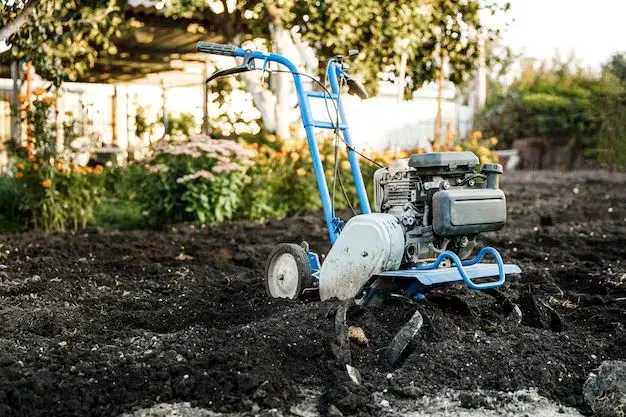Tillers are an invaluable tool for many gardeners and small-scale farmers. Whether you’re preparing beds for planting, cultivating between rows, or turning over cover crops, a tiller can make quick work of soil preparation tasks that would otherwise require hours of back-breaking labor with a shovel or hoe. But how often you need to use a tiller depends on several factors, including the size of your garden, what you grow, your soil type, and your personal preferences.
Page Contents
Size of the Area to be Tilled
The larger the area you need to till, the more frequently you’ll need to use a tiller. A small vegetable garden of just a few hundred square feet may only require tilling once or twice per year – at the start of the season before planting and perhaps once more midway through the summer to refresh beds. Larger market gardens, farms, and acreage may require more frequent tilling to prepare successive plantings and manage weeds and soil health.
Typical tilling frequency based on garden/farm size:
| Area Size | Typical Tilling Frequency |
|---|---|
| Less than 500 sq ft | 1-2 times per year |
| 500 – 2,000 sq ft | 2-3 times per year |
| 1/4 – 1 acre | 3-5 times per year |
| 1 – 5 acres | 5-10 times per year |
| 5+ acres | 10+ times per year |
Types of Crops
The types of crops you grow will also impact tilling frequency. Gardens and farms focused on annual vegetables, flowers, and herbs that are replanted each year will need more tilling than orchards, berries, asparagus, and other perennial crops. Tilling too much around the root zones of perennials can damage their root systems. Here are some general guidelines based on crop types:
| Crop Type | Typical Tilling Frequency |
|---|---|
| Annual vegetables | 2-5 times per year |
| Annual flowers | 1-2 times per year |
| Cover crops | 1-3 times per year |
| Perennial fruits & berries | 1 time per year or less |
| Perennial herbs | 1 time per year or less |
| Asparagus | 1 time per year or less |
| Orchards | 1 time per 3-5 years |
Soil Type
Soil properties like texture and organic matter content can determine both how much tilling is beneficial and how well the soil withstands tilling. Sandy soils with low organic matter are the easiest to till but benefit from more frequent tilling to improve water retention and nutrient content. Heavy clay soils can become compacted and may require occasional tilling to improve drainage and root penetration but are also prone to compaction from excessive tilling. Here are some general guidelines:
| Soil Type | Typical Tilling Frequency |
|---|---|
| Sandy | 3-5 times per year |
| Loamy | 2-4 times per year |
| Silty | 1-2 times per year |
| Clay | 1-2 times per year |
Conservation Tillage Systems
Many farmers are adopting conservation tillage systems that rely more on crop rotation, cover cropping, and retention of crop residues to build soil structure and fertility. These systems till much less frequently, using shallow and targeted tillage rather than repeatedly turning over the whole soil profile. Conservation tillage systems may only till in specific rows, beds, or planting holes and at frequencies of once every few years rather than multiple times per season.
Personal Preferences
While soil and crop characteristics should inform tilling frequency, personal factors also come into play. Some gardeners simply enjoy caring for soil and may find pleasure in frequently working the ground with a tiller. Others prefer to minimize tilling and will only do it when absolutely necessary. Health and physical abilities may also determine how much tilling a gardener is willing and able to undertake. The ideal tilling frequency can vary widely from one gardener to another.
Other Options for Soil Preparation
It’s important to note that frequent tilling is not essential for a productive garden or farm. Other techniques like applying organic mulches, planting cover crops, top-dressing with compost, and using low-till weed control methods can reduce reliance on tillers. Permaculture gardening and no-till farming systems often avoid tilling entirely once soils have been initially prepared, relying on other regenerative practices to build soil health. So while tillers can be useful tools, they are by no means mandatory for keeping soils productive.
Conclusion
Tilling frequency depends on a variety of factors, but generally smaller gardens focused on annual crops in lighter soils will require more tilling than larger farms growing perennials in heavy clay soils. Conservation tillage systems are reducing tilling frequencies on many farms. No-till methods can eliminate tilling altogether. While tillers are helpful for initial soil preparation, the best tilling frequency for long-term soil health is often less than conventional practices. Careful observation of your unique conditions will help determine optimal tilling frequency.
